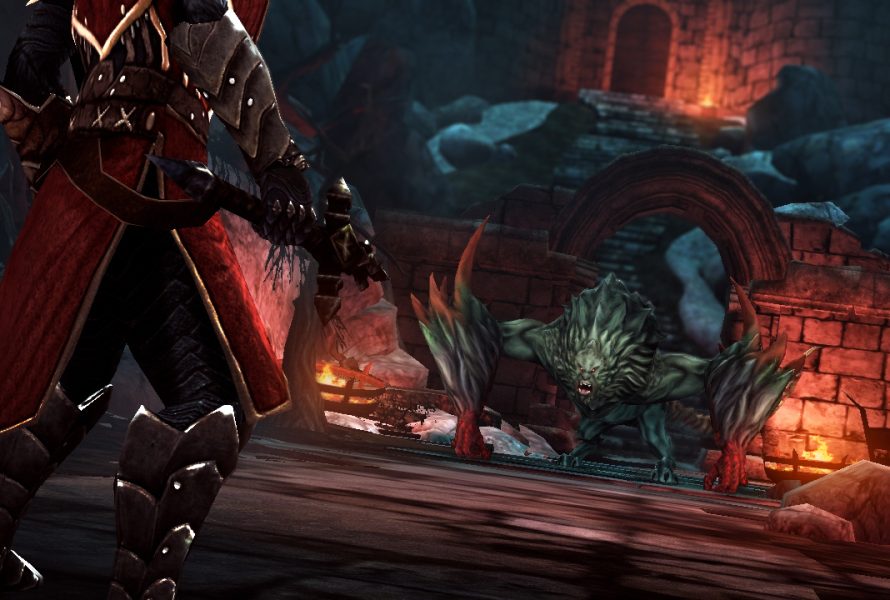The time has come to once again follow Simon Belmont on his quest to defeat Dracula, but the plot and presentation of Mirror of Fate only appears familiar. Beneath its viewable-in-3D, playable-in-2D, surface there is a storyline that walks down its own path, using the original series storyline as a guide rather than the rule. Exploration is merely a thing that impedes progress from point A to point B and combat is a major element, borrowing heavily from MercurySteam’s previous console iteration.
Much like Gabriel Belmont of Lords of Shadow, Simon wields a combat cross, i.e. whip, in primarily the same fashion. He’s given the capacity to perform a direct attack and an area attack along with a series of combos to tear through the army of foes separating him from his immortal enemy. On top of the combos, earned via leveling your character, there are items that grant special moves along with classic weapons to discover.
There’s more to the fighting than merely mashing a button or spamming a favorite combo/special move/weapon, and it’s due to the variety of the enemies you face. Monsters come in two types: flying and walking and it’s up to you to be to adapt accordingly. Some attacks are excellent to ward off those on the ground, but terrible against those in flight, and vice versa. You have to be nimble on your feet. You have to move, dodge, jump and parry with speed and precision.

Headphones, please!
The score for this game is moody and orchestral, much like the console version. The 3DS speakers are not up to par and sometimes the music strains out. Luckily, even the cheapest of headphones fixes this problem.
It’s the boss fights where the combat really shines. There isn’t a single boss that feels cheap, nor are they chumps. You have to watch the monster, learn its moves, know when it’s time to go on the defense and when it’s appropriate to attack. If you screw up, it’s okay, checkpoints are aplenty and you’ll know what not to do the second time around. And it’s right then, when you’ve moved in for the kill, that the Quick Time Events emerge.
Many games enjoy flirting with QTEs, Mirror of Fate thoroughly romances the mechanic. There are little QTEs, sprinkled here and there throughout the basic combat. Find a treasure chest and you’ll have to button mash to open it. Later on doors must be dealt with in the same manner. The worst is when an entire boss fight is handled via QTEs.
It feels like wasted potential, partially because the combat is actually fun, mostly because the plot that drives the adventure is genuinely interesting and well written. While I wasn’t expecting a rehash of the originals, which didn’t have much story to begin with, Mirror of Fate delivers the kind of depth I didn’t expect out of a 2D spin-off release of the franchise. Instead, this story is directly connected to MercurySteam’s reboot as a whole, delivering a continuation of the story that that they had only just started retelling.
While the re-imagined plot makes this an easy game to recommend to anyone who enjoyed Castlevania titles in the past, there’s no hiding some simple design decisions that detract from the experience as a whole. Aside from the QTEs, there’s an odd assortment of backtracking sprinkled throughout this otherwise linear game.

The first is performed through your own volition as you discover new items that allow access to older parts of the castle you couldn’t access before. The rewards for delving into these nooks and crannies, however, are dull. On one hand you might find an upgrade that raises your maximum health, but the time invested going back through the level is hardly worth the scant increase you receive, especially in comparison to the amount of damage enemies deal. The second is required. There are fortunately only a couple of points in the game where you’re forced to retread old steps just for the sake of acquiring a key, only to have to backtrack again in order to get to the door the key was meant to unlock.
All things considered, Mirror of Fate is still a decent game, one that is merely injured by some elements of poor design. It’s a unique approach to rebooting a franchise, one that doesn’t seek to reestablish the rules, but instead utilize them as a guide, thus allowing this new version to travel its own direction.